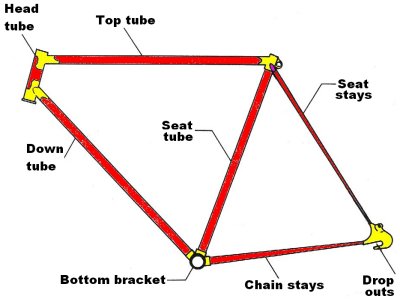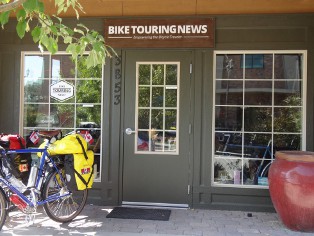This is a topic that will always create controversy. There are as many ideas about what a touring bicycle should be as there are touring bicyclists. Especially when it comes to frame materials. There are many , many articles and opinions about frame materials, and that’s a tar baby with which I’m not willing to wrestle.
Some features, however, undeniably contribute to a bicycle which is suitable for carrying a load and for spending long days in the saddle. For clarity and as a reference, here is a drawing of a bicycle frame with the various parts named.

You will have to imagine the fork, which inserts into the head tube to hold the front wheel.
Where to begin? Hmmmmm. How about size? OK.
Walk into any bike shop to get sized for a bike and you will hear about stand over height. Stand over height is simply a measurement from the floor to the top of the top tube at a point roughly midway between the seat tube and the head tube of a bicycle with wheels and tires mounted. Obviously, being able to “stand over” the bike is a benefit. That is where the usefulness of this rule of thumb ends. The bike shop sales person will undoubtedly tell you that on a “road bike” you want 2 inches (or something) between your crotch and the top tube. What if the top tube slopes a little, or a lot? How long is the top tube in relation to the seat tube and resultant stand over height? It’s more complicated than stand over height.
Most frames will have a designated size. This is usually a measurement from the center of the bottom bracket to the top of the top tube measured parallel to the seat tube. Again, this is sort of a meaningless measurement unless the other tube dimensions are known.
What’s a person to do? Find a bike shop or bike company which specializes in touring bikes. Talk to them and get a feeling for how much traveling they have done by bicycle. See what kind of bikes they stock or sell. Most bike shops do not stock or know touring bicycles and this can be a frustrating search, but don’t give up. Be wary of buying a bike that is too small. In general, a race bike will be smaller than a touring bike for a given person. Be careful not to get trapped into the truisms about smaller frames being lighter or more responsive or stiffer. What you are worried about is being comfortable! A too small frame can make it difficult to carry panniers without interfering with the rider’s feet, and may make the loaded bike less stable.
What about weight?
If you watch people in bike shops, you will see most of them pick up the bicycles to see how much they weigh. It’s actually quite entertaining. As a touring cyclist you should be more worried about durability… of the frame, of the components, and of the wheels especially. Not to say heavier is automatically more durable, but light weight bikes and wheels have no place on a self supported tour.
In Touring Bicycle (Part 2) I will go into more detail about specific features which should be considered when shopping for a good bicycle for self supported touring .

James November 4, 2012, 1:33 am
Great post! Just letting you know that I’ve included a link to this page (primarily for the easy diagram you’ve posted) in my latest blog post. I inserted the direct link to this page, rather than directly to the picture, because (from what I’ve read) your site looks like a great resource for any cyclist (at least, any cyclist interested in touring). Please let me know if you would like me to remove the link. You can see the post here ( http://betterbikeblog.wordpress.com/2012/11/04/fitting-your-bike-to-you/) if you would like.